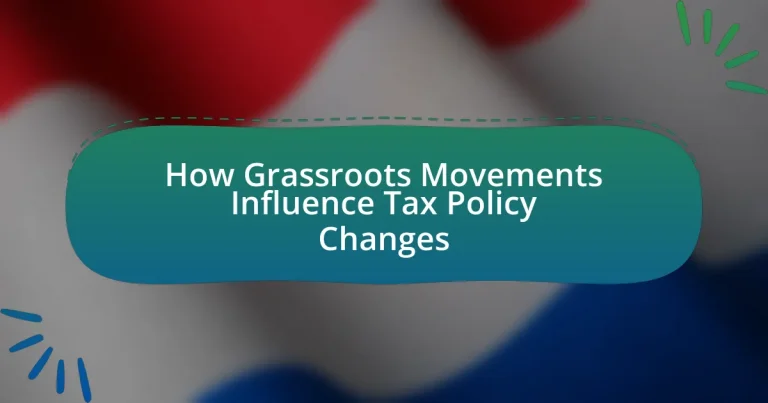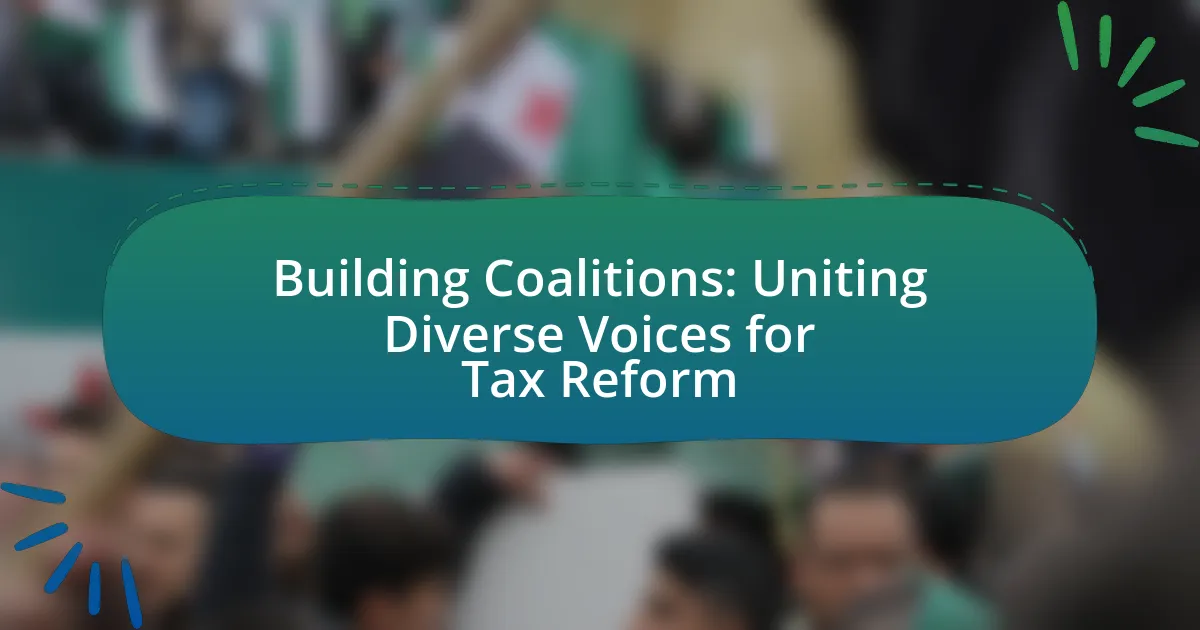Grassroots movements are organized efforts by ordinary citizens aimed at influencing political decisions, particularly in tax policy changes. These movements arise from community concerns about economic inequality and social justice, employing strategies such as public demonstrations, social media campaigns, and local organizing to advocate for reforms. The article examines how grassroots movements initiate discussions on tax policy, mobilize community support, and influence policymakers, highlighting notable examples like the Tea Party and the Fight for $15. It also addresses the challenges these movements face, including limited resources and opposition from established interests, while emphasizing the importance of community engagement and strategic partnerships in achieving successful tax policy changes.
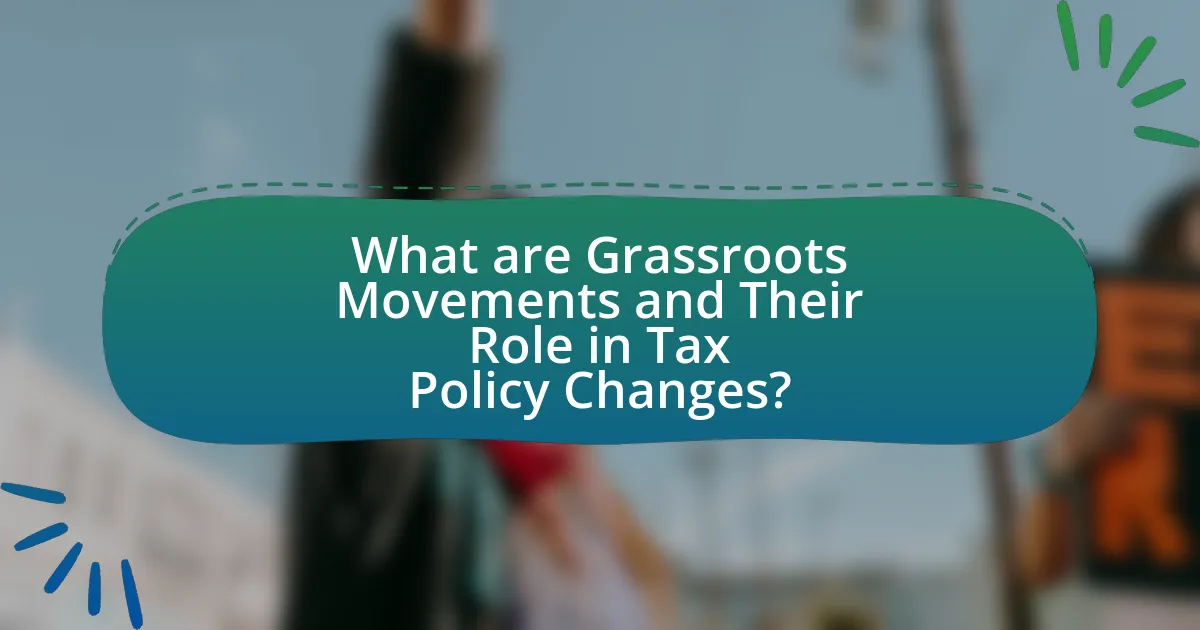
What are Grassroots Movements and Their Role in Tax Policy Changes?
Grassroots movements are organized efforts by ordinary people to influence political decisions, including tax policy changes. These movements often arise from community concerns about economic inequality, social justice, or specific tax burdens, mobilizing citizens to advocate for reforms. For instance, the Tea Party movement in the United States significantly impacted tax policy discussions in the late 2000s by promoting lower taxes and reduced government spending, which led to legislative changes at both state and federal levels. Additionally, grassroots campaigns like the Fight for $15 have pushed for higher minimum wages, indirectly influencing tax policies related to income and corporate taxation. Such movements demonstrate the power of collective action in shaping tax policy through advocacy, public demonstrations, and lobbying efforts.
How do grassroots movements initiate tax policy discussions?
Grassroots movements initiate tax policy discussions by mobilizing community members to advocate for specific tax reforms. These movements often leverage social media, public demonstrations, and local organizing to raise awareness about tax issues, thereby influencing public opinion and policymakers. For instance, the Tea Party movement in the United States effectively used grassroots strategies to challenge tax policies in the late 2000s, leading to significant political discourse around taxation. This approach demonstrates how grassroots efforts can shape the agenda and prompt legislative discussions on tax policy.
What strategies do grassroots movements use to raise awareness about tax issues?
Grassroots movements utilize various strategies to raise awareness about tax issues, including community organizing, social media campaigns, and public demonstrations. Community organizing involves mobilizing local residents to engage in discussions and educational events that highlight the impact of tax policies on their lives. Social media campaigns leverage platforms like Twitter and Facebook to disseminate information quickly, reaching a broader audience and encouraging public discourse. Public demonstrations, such as rallies or protests, visually represent collective concerns and draw media attention, amplifying the message. These strategies have proven effective; for instance, the “Tax Day” protests in the United States have historically garnered significant media coverage, raising public awareness about tax reform issues.
How do grassroots movements mobilize community support for tax policy changes?
Grassroots movements mobilize community support for tax policy changes by engaging local citizens through education, advocacy, and collective action. These movements often organize informational campaigns that highlight the impact of tax policies on the community, using data and personal stories to illustrate their points. For instance, the “Fight for $15” movement effectively raised awareness about wage disparities and tax implications, leading to increased public support for minimum wage increases in various cities. Additionally, grassroots organizations utilize social media platforms to amplify their messages, mobilize supporters for rallies, and encourage community members to contact their representatives, thereby creating a unified voice that can influence policymakers. This approach has been validated by studies showing that community engagement significantly increases the likelihood of policy changes, as seen in the successful advocacy for tax reforms in several states.
Why are grassroots movements important in shaping tax policy?
Grassroots movements are important in shaping tax policy because they mobilize public opinion and advocate for changes that reflect the needs and priorities of local communities. These movements often highlight issues such as income inequality and social justice, which can influence policymakers to consider reforms that address these concerns. For example, the Tea Party movement in the United States significantly impacted tax policy discussions by advocating for lower taxes and reduced government spending, leading to legislative changes at both state and federal levels. Additionally, grassroots campaigns can effectively organize voters, increasing political engagement and pressuring elected officials to respond to constituents’ demands, thereby shaping tax policy in a way that aligns with the public’s interests.
What impact do grassroots movements have on public opinion regarding tax policies?
Grassroots movements significantly shape public opinion regarding tax policies by mobilizing community engagement and raising awareness about specific issues. These movements often highlight the perceived inequities in tax systems, leading to increased public discourse and pressure on policymakers. For instance, the Tea Party movement in the United States effectively influenced public sentiment against tax increases, contributing to a broader anti-tax narrative that affected electoral outcomes and legislative decisions. Research indicates that grassroots campaigns can sway public opinion by utilizing social media and local organizing to disseminate information and rally support, thereby creating a more informed electorate that advocates for specific tax reforms.
How do grassroots movements influence policymakers and legislative processes?
Grassroots movements influence policymakers and legislative processes by mobilizing public support and raising awareness on specific issues. These movements often utilize strategies such as organizing protests, engaging in community outreach, and leveraging social media to amplify their messages, which can lead to increased pressure on legislators to respond to constituents’ demands. For instance, the Tea Party movement in the United States significantly impacted tax policy discussions in the early 2010s by advocating for lower taxes and reduced government spending, which resulted in lawmakers prioritizing these issues in legislative agendas. Additionally, grassroots campaigns can provide policymakers with data and testimonials that highlight the real-world implications of proposed legislation, thereby shaping the narrative and influencing decision-making processes.
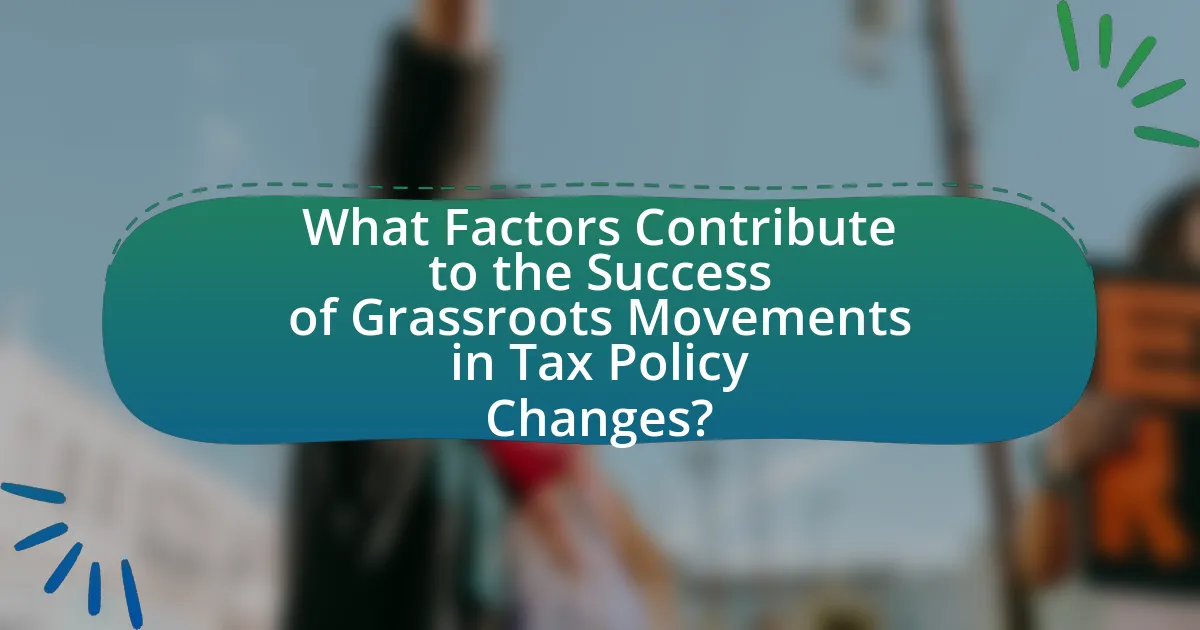
What Factors Contribute to the Success of Grassroots Movements in Tax Policy Changes?
Grassroots movements succeed in tax policy changes due to effective organization, public engagement, and strategic messaging. Effective organization allows these movements to mobilize resources and volunteers efficiently, as seen in the 2011 Occupy Wall Street movement, which raised awareness about income inequality and influenced discussions on tax reform. Public engagement is crucial; movements that connect with diverse community members can build broader coalitions, exemplified by the Fight for $15 campaign, which united workers across various sectors to advocate for higher wages and tax equity. Strategic messaging, which resonates with the public’s values and concerns, enhances visibility and support, as demonstrated by the successful campaigns for tax reform in various states that framed tax issues in terms of fairness and social justice.
How does community engagement affect the effectiveness of grassroots movements?
Community engagement significantly enhances the effectiveness of grassroots movements by fostering a sense of ownership and collective action among participants. When individuals actively participate in their communities, they are more likely to mobilize resources, share information, and advocate for policy changes that reflect their collective interests. For instance, research by the Stanford Social Innovation Review indicates that grassroots movements with high levels of community involvement are more successful in achieving their goals, as they can leverage local networks and build trust among constituents. This engagement not only amplifies voices but also creates a more informed and motivated base that can effectively challenge existing tax policies and advocate for reforms.
What role does social media play in grassroots movements advocating for tax policy changes?
Social media serves as a crucial tool for grassroots movements advocating for tax policy changes by facilitating communication, mobilization, and awareness. It allows activists to share information rapidly, organize events, and engage with a broader audience, thereby amplifying their message. For instance, platforms like Twitter and Facebook have been instrumental in campaigns such as the “Tax the Rich” movement, which gained significant traction through viral posts and hashtags, leading to increased public discourse on tax equity. Research indicates that social media can enhance civic engagement, with a study by the Pew Research Center showing that 69% of adults in the U.S. use social media, making it an effective channel for grassroots organizations to reach and influence potential supporters.
How do partnerships with other organizations enhance grassroots efforts?
Partnerships with other organizations enhance grassroots efforts by providing additional resources, expertise, and networks that amplify the impact of local initiatives. For instance, collaborations can lead to increased funding opportunities, allowing grassroots movements to expand their reach and effectiveness. A study by the Stanford Social Innovation Review highlights that organizations that engage in partnerships can leverage each other’s strengths, resulting in more comprehensive strategies to address community issues. This synergy not only enhances visibility but also fosters a united front, making it easier to influence policy changes, such as tax reforms, by presenting a consolidated voice to policymakers.
What challenges do grassroots movements face in influencing tax policy?
Grassroots movements face significant challenges in influencing tax policy, primarily due to limited resources and political access. These movements often lack the financial backing and organizational infrastructure that larger entities possess, which hampers their ability to effectively lobby policymakers. For instance, a study by the National Bureau of Economic Research highlights that grassroots organizations typically operate with smaller budgets compared to established interest groups, making it difficult to compete in advocacy efforts. Additionally, grassroots movements may struggle to gain media attention, which is crucial for raising public awareness and support for their tax policy initiatives. This lack of visibility can further diminish their influence in the political arena, as evidenced by the limited success of many grassroots campaigns in achieving substantial tax reforms.
How do funding and resource limitations impact grassroots movements?
Funding and resource limitations significantly hinder grassroots movements by restricting their ability to mobilize, organize, and sustain campaigns. These limitations often result in reduced outreach efforts, fewer events, and diminished capacity to engage with the community, which are essential for building momentum and support. For instance, a study by the National Committee for Responsive Philanthropy found that grassroots organizations with limited funding struggle to maintain staff and resources, leading to decreased effectiveness in advocacy efforts. Consequently, without adequate financial backing, grassroots movements may fail to influence tax policy changes, as they lack the necessary tools to effectively communicate their messages and rally public support.
What opposition do grassroots movements encounter from established interests?
Grassroots movements encounter significant opposition from established interests, primarily in the form of political resistance, financial influence, and media manipulation. Established interests, such as corporations and political elites, often leverage their resources to undermine grassroots initiatives by lobbying against proposed changes, funding counter-campaigns, and utilizing their media connections to shape public perception negatively. For instance, during the fight for tax reform in the United States, large corporations have historically spent millions on lobbying efforts to maintain favorable tax rates, directly opposing grassroots movements advocating for equitable tax policies. This dynamic illustrates how established interests can effectively stifle grassroots efforts through strategic opposition.
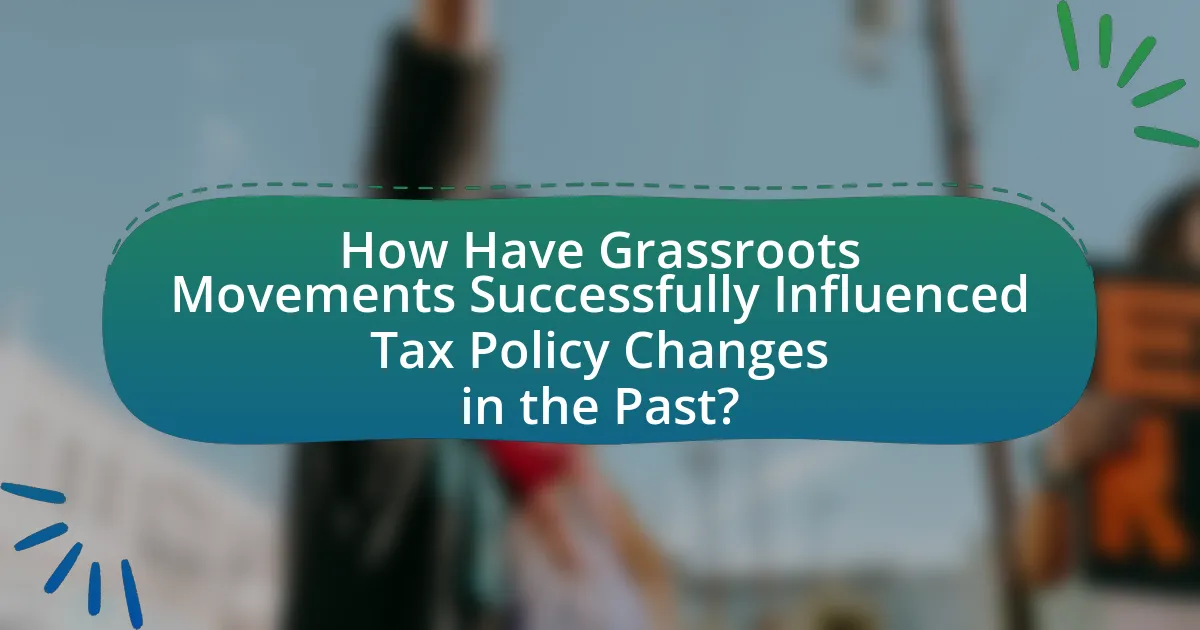
How Have Grassroots Movements Successfully Influenced Tax Policy Changes in the Past?
Grassroots movements have successfully influenced tax policy changes by mobilizing public support and advocating for specific reforms. For instance, the Tea Party movement in the United States significantly impacted tax policy by promoting lower taxes and reduced government spending, which led to the implementation of tax cuts during the early 2010s. Additionally, the Occupy Wall Street movement raised awareness about income inequality and corporate taxation, prompting discussions that influenced tax reform proposals aimed at increasing taxes on the wealthy. These movements utilized social media and community organizing to amplify their messages, demonstrating that collective action can lead to tangible policy changes.
What are some notable examples of grassroots movements affecting tax policy?
Notable examples of grassroots movements affecting tax policy include the Tea Party movement in the United States, which emerged in 2009 and successfully influenced tax cuts and reduced government spending through local activism and national campaigns. Another example is the Fight for $15 movement, which advocates for a $15 minimum wage and has led to changes in tax policy related to wage taxation and income redistribution in various states and cities. Additionally, the Occupy Wall Street movement highlighted income inequality and pushed for higher taxes on the wealthy, contributing to discussions around tax reform in the U.S. These movements demonstrate the power of grassroots organizing in shaping tax policy through public engagement and advocacy.
How did specific grassroots campaigns lead to significant tax reforms?
Specific grassroots campaigns have led to significant tax reforms by mobilizing public support and influencing policymakers through organized advocacy. For example, the “Tea Party” movement in the United States, which emerged in 2009, galvanized citizens around issues of taxation and government spending, ultimately contributing to the passage of tax cuts in 2017 under the Tax Cuts and Jobs Act. This campaign utilized social media and local meetings to raise awareness and pressure legislators, demonstrating how grassroots efforts can effectively shape tax policy. Additionally, the “Fight for $15” campaign, advocating for a higher minimum wage, has prompted discussions on tax reforms related to income inequality and corporate taxation, showcasing the broader impact of grassroots movements on fiscal policy.
What lessons can be learned from successful grassroots movements in tax policy advocacy?
Successful grassroots movements in tax policy advocacy demonstrate the importance of community engagement, strategic messaging, and coalition-building. These movements effectively mobilize local constituents to influence policymakers by highlighting the direct impact of tax policies on their lives, as seen in the successful campaigns for tax reform in various states. For instance, the “Fair Tax Coalition” in Massachusetts united diverse groups to advocate for equitable tax policies, resulting in significant legislative changes. This illustrates that grassroots movements can leverage collective voices to create pressure on decision-makers, ultimately leading to more responsive tax policies.
What are the current trends in grassroots movements related to tax policy?
Current trends in grassroots movements related to tax policy include increased advocacy for wealth redistribution, heightened focus on corporate tax accountability, and mobilization against regressive tax measures. These movements are often driven by community organizations and coalitions that emphasize social equity and economic justice. For instance, the “Tax the Rich” campaign has gained traction, highlighting the disparity in tax burdens between wealthy individuals and lower-income populations. Additionally, grassroots efforts have successfully influenced local governments to adopt progressive tax policies, as seen in cities like San Francisco, where community-led initiatives pushed for higher taxes on large corporations to fund public services. These trends reflect a growing awareness and activism around tax policy’s impact on social inequality and economic stability.
How are emerging technologies shaping grassroots movements in tax advocacy?
Emerging technologies are significantly shaping grassroots movements in tax advocacy by enhancing communication, mobilization, and data analysis capabilities. These technologies, such as social media platforms, crowdfunding tools, and data analytics software, enable grassroots organizations to reach wider audiences, organize campaigns more efficiently, and leverage data to support their arguments. For instance, social media allows for rapid dissemination of information and mobilization of supporters, as seen in campaigns like the “Tax the Rich” movement, which gained traction through viral online content. Additionally, crowdfunding platforms have enabled grassroots groups to raise funds for advocacy efforts, allowing them to compete with larger organizations. Data analytics tools help these movements identify key demographics and tailor their messaging, increasing the effectiveness of their campaigns. Overall, the integration of emerging technologies into grassroots tax advocacy has transformed how these movements operate, making them more agile and impactful.
What new issues are grassroots movements focusing on in tax policy today?
Grassroots movements today are focusing on issues such as wealth inequality, corporate tax avoidance, and the implementation of progressive tax systems. These movements advocate for policies that aim to close tax loopholes exploited by large corporations, ensuring that they contribute fairly to public finances. For instance, the “Tax the Rich” campaign emphasizes the need for higher taxes on the ultra-wealthy to fund social programs, reflecting a growing concern over the disparity in wealth distribution. Additionally, grassroots organizations are increasingly mobilizing around climate-related taxes, pushing for carbon taxes that hold polluters accountable while generating revenue for sustainable initiatives. These issues are supported by data indicating that wealth concentration has reached historic levels, with the top 1% holding more wealth than the bottom 90% combined, highlighting the urgency of reform in tax policy.
What practical steps can individuals take to support grassroots movements in tax policy changes?
Individuals can support grassroots movements in tax policy changes by actively participating in local advocacy efforts, such as attending town hall meetings and engaging with community organizations focused on tax reform. This participation helps amplify the voices of those advocating for change and fosters a collective approach to influence policymakers. Additionally, individuals can contribute by donating to grassroots organizations that prioritize tax policy reform, which provides them with the necessary resources to mobilize campaigns effectively. Research indicates that grassroots movements can significantly impact policy outcomes; for example, the 2017 Tax Cuts and Jobs Act was influenced by various grassroots campaigns advocating for equitable tax policies. By leveraging social media platforms, individuals can also raise awareness and mobilize support for specific tax initiatives, further enhancing the reach and effectiveness of grassroots movements.
